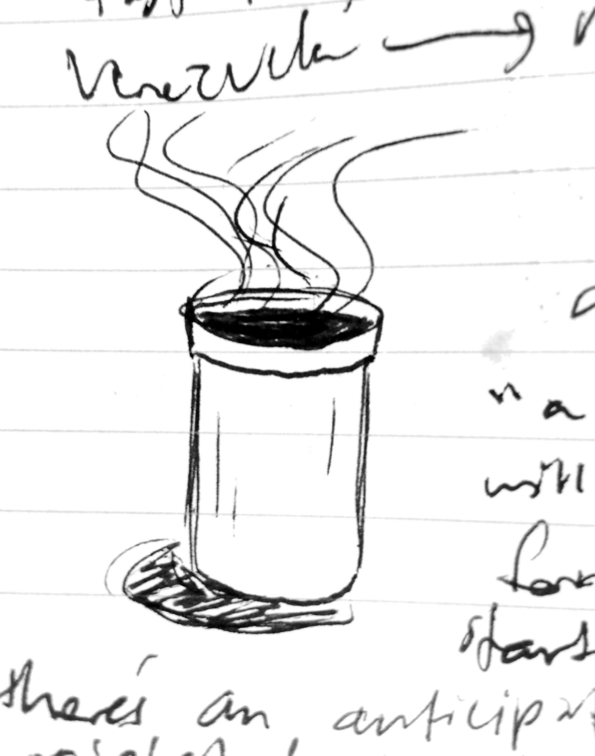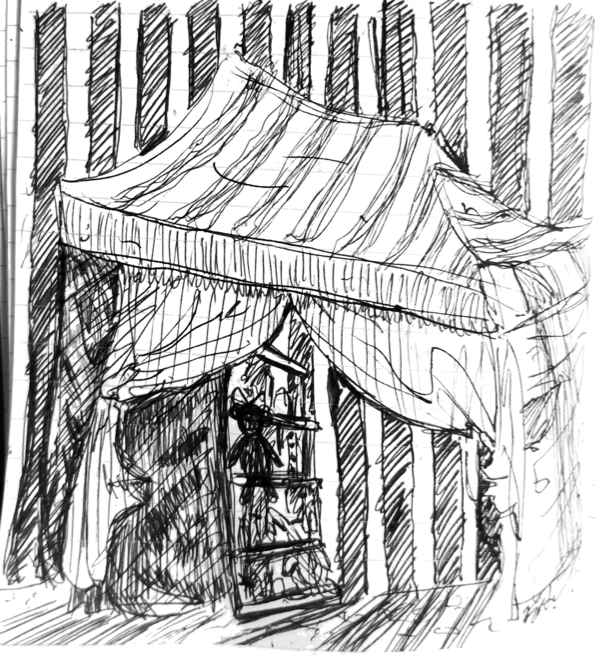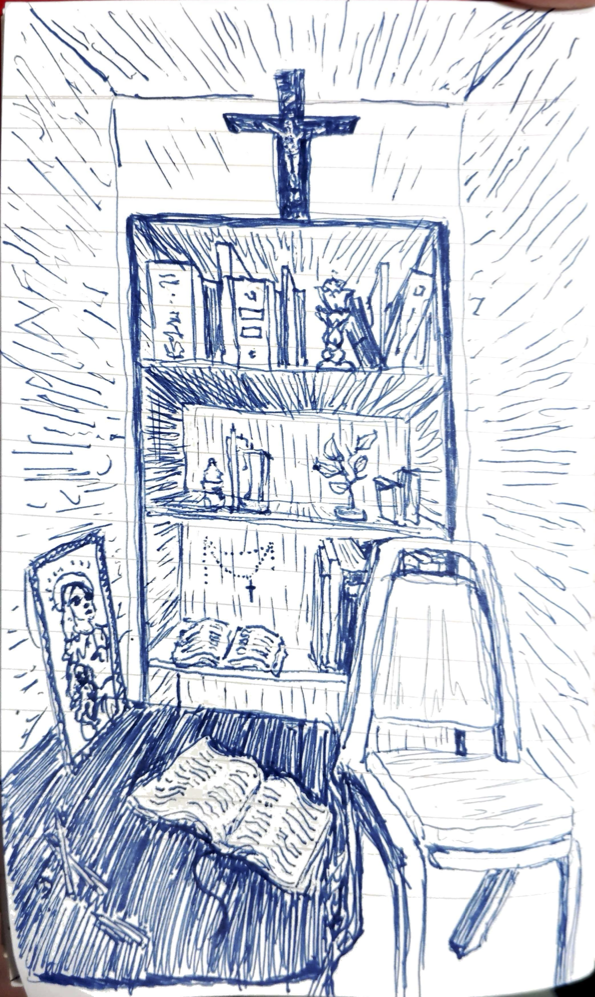
My pen glides across the glistening page of my pocket notebook, wet from morning dew, as I capture the large red “Private Property” sign on the front gate of Our Lady of Guadalupe Migrant Shelter in Barrio Logan, San Diego. The thin sheet of rusty metal was hung with two twisted strings, designed to keep out ICE officers without a warrant.
The adversity of the migrant experience was apparent before we even stepped through the gate, but I never expected what we were going to hear once inside.
On Feb. 1, 2025, I began the journey to Tijuana with my Point Loma Nazarene University peers as part of the Ministry with Mexico program.
The trip’s theme, summarized through the phrase: “It’s not weird; it’s different” by PLNU Honors Professor Jennifer Guerra-Aldana, encouraged students to rethink their understanding of Christian community, practice and identity.
Professor Guerra-Aldana, Coordinator and Student Initiatives Lead Marissa Salgado and Ministry with Mexico Director Jeff Jimenez led our group. First, we visited the Private Property Migrant Shelter in San Diego.

We were immediately welcomed in with steaming styrofoam cups of instant coffee. Pastor Scott Santarosa organized us into small groups to hear the travel stories of three migrants living at the shelter.
Karina, her husband and their 8- and 6-year-old children traveled over 3,000 miles in five months from Venezuela to San Diego, seeking asylum from their country’s dictatorship and a medical crisis. Doctors there earned $100 a month, causing a “brain drain” where medics immigrated for better pay, leaving Venezuelans desperate for care.
Fearing for her family’s health, Karina crossed eight countries with two little ones. After two and a half days through the most dangerous section, the Darien Gap jungle, Karina gained an infection and lost three toenails.
The smooth scrapes of my pen on paper provided a backtrack to the migrant’s voice. The weight of Karina’s fear pressed my hand on the pen hard; I couldn’t stop moving my pen. After sketching the coffee cup, thick black arcs and swirls began to fill the empty space, an inky layer of darkness enveloping the page. By the end of the talk, the page was limp with ink, and I slumped back into my chair.
Practicing empathy takes a toll. When I closed my notebook, I knew the stained page wouldn’t disappear, to be followed by precisely lined white paper once Karina entered America. The black blemishes would shine through the thin sheets ahead of it, and there would be more darkness to come. Yet, it was the gradation of values in the notebook, each dark and light page together, that came together to create a beautiful end product that connected us.
Despite the horrors she shared, Karina spoke with vibrancy and passion, praising Dios, or God. Her gratitude to be present at the migrant shelter radiated off of her, a warmth of faith and resilience. I felt overwhelmed with the despair and the joy interwoven in the story. Overwhelmed with the presence of God through this woman, so powerful that it transcended beyond our language barrier.
I asked Karina in broken Spanish how much her voyage had cost in total. “Quatro mil” was her answer: $4000.
Her answer left me with so many questions. What happened to the millions alongside Karina in the Darien Gap who didn’t have the money to make it out? Why did her family get to cross the border, when so many in the same situation are rejected every day? Where was God on their perilous journeys?

More curiosities about God’s character rose within me as we visited an isolated Border Church on the U.S. side named “Whiskey 8.”
The emptiness of the U.S. side was eerily striking, as we gazed along the tall metal bars, numerous as the stars. I quickly sketched the Border Church, outlining the detail of a Minnie Mouse toy a migrant child had left behind. The abandoned toy was an image I will never unsee, as I felt for the little girl who left it behind.
Whiskey 8 was humble, yet the purpose of our Christian gathering remained the same – to seek God in mutuality.
In John 1:39 in the Bible, Jesus calls us to come and see. Standing there with our hands on the cold, steel bars, looking into “No Man’s Land” between the two divided countries, we came and saw the visual representation of division between God’s people.
But feeling the soft, billowing canvas, full of supplies and love, was a reminder of God’s abundance. He was working through the volunteers at Whiskey 8 to give little ounces of hope and solidarity along their journey.
Despite the structural differences to my home church, I felt the same thoughtful, contemplative stillness I do every Sunday. Experiencing God in the humble tents brought me to think about how much I limit myself and others by considering church the “normal” way to worship, the right way. My feelings of unease and hesitation to approach the border were all part of the journey – it wasn’t weird; it was different.

We walked two miles into Tijuana by foot after crossing the border, and then piled onto a bus for the bumpy ride to Casa del Migrante, a four-story Catholic migrant shelter.
It was 6 p.m. and freezing outside when we arrived. The shelter looked like a taller version of Goodwin, my campus dorm, with a courtyard in the middle. We were greeted with smiles from all over Latin America. The shelter felt like home, and I slept soundly on a top bunk in our 12 person room.
The shelter had a gym, dining area and a prayer room. These small luxuries felt like an acknowledgment of the migrants as humans deserving of physical, mental and spiritual self-care, the opposite of the message the U.S. border patrol were sending.
I spent some time in the prayer space the next morning. As I sketched the cluttered bookcase, I was reminded of PLNU’s prayer chapel. The stacks of colorful prayer request cards sticking out of the wooden slits had a similar messy humane feeling to the room I was in. God was everywhere within and outside of that room, from each word in the palabra, or word in the open Spanish Bible to the never-ending stretch of the border.
At the end of the day, we crossed into the U.S. in under 10 minutes. So easily. Just like that, we stepped foot into a land thousands of people travel thousands of miles to get to, many to be rejected. I felt pulled down by their despair, but also lifted by their incredible hope and resilience. Pulling out my notebook one last time, I wrote this verse:
“For I know the plans I have for you, declares the Lord, plans to prosper you and not to harm you, plans to give you hope and a future” (Jeremiah 29:11).
